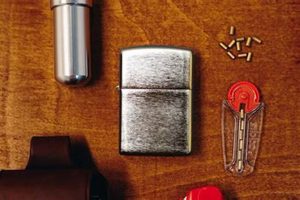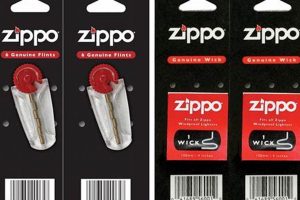A Zippo lighter’s sparking mechanism relies on a small, hard, cylindrical piece of ferrocerium held under spring tension against a toothed wheel. When the wheel is spun, friction against the ferrocerium creates sparks that ignite the lighter fluid. Occasionally, this component can become lodged, preventing the wheel from turning and the lighter from producing a spark.
A properly functioning sparking mechanism is essential for the lighter’s operation. The uninterrupted supply of sparks ensures reliable ignition of the fuel, which is the primary function of the device. Historically, these lighters have been valued for their dependability, particularly in demanding environments. A jammed component compromises this reliability. Understanding the cause and solution to this common issue helps maintain the lighter’s functionality.
The following sections will explore the typical causes of this malfunction, methods for resolving the issue, and preventative measures to ensure continued reliable operation.
Troubleshooting a Zippo Lighter’s Spark Mechanism
Several techniques can be employed to address a malfunctioning sparking mechanism in a Zippo lighter. These methods range from simple adjustments to more involved procedures.
Tip 1: Inspect the Lighter for Obstructions: Carefully examine the area around the flint wheel. Debris, pocket lint, or other foreign objects can interfere with the mechanism. Use a small brush or compressed air to remove any obstructions.
Tip 2: Check the Flint Spring Tension: Ensure the spring provides adequate pressure against the ferrocerium. If the spring feels loose or weak, it may require replacement.
Tip 3: Examine the Ferrocerium for Wear: The ferrocerium wears down with use. If it is too short or excessively worn, replacement is necessary. Unscrew the flint screw at the bottom of the lighter to access and replace the ferrocerium.
Tip 4: Ensure Proper Flint Installation: After replacing the ferrocerium, ensure it is correctly seated within the lighter casing. Incorrect installation can lead to malfunctions.
Tip 5: Address Flint Tube Obstructions: Occasionally, the flint tube itself can become obstructed. A small pin or needle can be carefully used to clear any blockages.
Tip 6: Lubricate the Flint Wheel: A small amount of lighter fluid can be applied to the flint wheel axle to ensure smooth rotation. Avoid over-lubrication, which can attract debris.
By following these tips, one can often restore a Zippo lighter’s sparking mechanism to proper working order. Regular maintenance, including cleaning and flint replacement, can prevent future issues and prolong the lighter’s lifespan.
These troubleshooting steps provide a practical guide for maintaining a functional lighter. Further resources can be found online or through authorized service centers.
1. Obstructed Flint Tube
An obstructed flint tube is a common cause of ignition failure in Zippo lighters. The tube, a small channel within the lighter casing, houses the flint and guides it towards the sparking wheel. Obstructions within this tube prevent the flint from moving freely, hindering contact with the wheel and thus preventing spark generation. This can manifest as a lighter that seems to function normally the wheel turns but produces no spark. The obstruction effectively immobilizes the flint, rendering the sparking mechanism useless.
Several factors can contribute to a blocked flint tube. Accumulation of debris, such as pocket lint, dust, or fragments of the flint itself, is a primary culprit. Corrosion, though less common, can also constrict the tube. In some cases, a deformed flint can become lodged, effectively blocking the passage. The practical significance of understanding this connection lies in the ability to diagnose and resolve the issue. Recognizing that a stuck flint may be a symptom of an obstructed tube allows for targeted troubleshooting, avoiding unnecessary replacement of other components.
Addressing an obstructed flint tube typically involves clearing the blockage. A small, thin implement, such as a straightened paperclip or a specialized lighter tool, can be carefully inserted into the tube to dislodge debris. Compressed air can also be effective in removing loose particles. Preventative measures, such as regular cleaning and proper storage, minimize the risk of future obstructions. A clear flint tube is essential for reliable lighter function, ensuring consistent spark generation and fuel ignition.
2. Worn Flint
A worn flint is a frequent contributor to Zippo lighter malfunctions, often perceived as a stuck mechanism. While not physically jammed, a depleted flint loses its ability to generate sparks reliably, mimicking the symptoms of a stuck component. Understanding the impact of flint wear is crucial for effective lighter maintenance.
- Reduced Spark Generation
As the flint wears down through repeated use, its mass decreases, reducing the surface area available for friction against the sparking wheel. This diminished contact area results in fewer and weaker sparks, eventually leading to ignition failure. The lighter may appear to function mechanically, with the wheel turning freely, but the weakened sparks are insufficient to ignite the fuel.
- Increased Pressure Required
A smaller flint requires greater pressure against the sparking wheel to generate adequate friction for sparking. This increased pressure can create a sensation of resistance when operating the wheel, potentially misconstrued as a mechanical obstruction. Users might apply excessive force, potentially damaging the sparking wheel or other components.
- Uneven Wear and Fragmentation
Flint wear is not always uniform. Uneven wear can create sharp edges or fragments that may impede smooth operation of the sparking mechanism. Small pieces of broken flint can lodge in the flint tube or interfere with the wheel’s rotation, creating further complications.
- Impact on Lighter Reliability
A worn flint directly impacts lighter reliability. Intermittent sparking or complete ignition failure compromises the lighter’s primary function. Regular flint replacement is essential to maintain consistent performance and prevent the frustration of an unreliable lighter.
Recognizing the symptoms of a worn flint, such as diminished spark generation and increased resistance when operating the wheel, allows for timely replacement and prevents misdiagnosis of more complex mechanical issues. Regular maintenance, including proactive flint replacement, is crucial for ensuring the continued reliability and longevity of a Zippo lighter.
3. Loose Flint Spring
A loose flint spring is a significant factor contributing to the perception of a stuck flint in a Zippo lighter. While the flint itself may not be physically jammed, a weakened or loose spring compromises the lighter’s sparking mechanism, mimicking the symptoms of a stuck component. Understanding the spring’s function and the impact of its condition is crucial for effective troubleshooting and maintenance.
- Insufficient Pressure on the Flint
The flint spring’s primary role is to maintain consistent pressure between the flint and the sparking wheel. This pressure is essential for generating the friction necessary for spark creation. A loose spring fails to exert adequate force, resulting in weak or nonexistent sparks, even with a new flint. This lack of spark can be misinterpreted as a stuck flint.
- Inconsistent Spark Generation
A loose spring allows for variations in the pressure applied to the flint. This inconsistency leads to erratic sparking, with some attempts producing strong sparks while others fail completely. This intermittent functionality can be frustrating and may lead to the incorrect assumption of a physical obstruction.
- Increased Wear on the Flint and Wheel
The inconsistent pressure from a loose spring can accelerate wear on both the flint and the sparking wheel. The inadequate and uneven contact can create irregular wear patterns, potentially damaging both components and shortening their lifespan.
- Difficulty in Generating Sparks
Users may experience increased difficulty in generating sparks with a loose flint spring. The reduced pressure necessitates greater force on the sparking wheel, often leading to the perception of a jammed mechanism. This can result in excessive force being applied, potentially damaging the lighter.
Addressing a loose flint spring often involves replacing the spring altogether. Attempting to tighten or adjust a weakened spring is usually ineffective and may cause further damage. Regular inspection and maintenance, including spring replacement when necessary, are vital for ensuring reliable lighter performance and preventing the misdiagnosis of a stuck flint when the underlying issue is a loose spring.
4. Debris Interference
Debris interference is a common culprit behind lighter malfunctions, often mimicking the symptoms of a stuck flint. Accumulation of foreign matter within the lighter’s mechanism disrupts the delicate interplay of components, leading to ignition failures and operational difficulties. Understanding the nature and impact of debris interference is crucial for maintaining a functional lighter.
- Types of Debris
Various materials can infiltrate a lighter’s mechanism. Pocket lint, dust, tobacco fragments, and even small metallic shavings are frequent offenders. These particles, often microscopic, can accumulate over time, gradually hindering the lighter’s operation.
- Impact on the Flint Mechanism
Debris can obstruct the flint tube, preventing the flint from making proper contact with the sparking wheel. It can also interfere with the wheel’s rotation, creating friction and resistance. Even minute particles can significantly impair spark generation, leading to ignition failures.
- Symptoms of Debris Interference
Debris interference often manifests as difficulty in turning the sparking wheel, inconsistent spark production, or a complete absence of sparks. These symptoms can be easily mistaken for a stuck flint or other mechanical failures, leading to misdiagnosis and ineffective troubleshooting.
- Prevention and Mitigation
Regular cleaning is essential for preventing debris buildup. Compressed air can effectively remove loose particles. Disassembling the lighter and carefully cleaning individual components can address more persistent contamination. Proper storage, such as keeping the lighter in a protective case, also minimizes debris ingress.
Recognizing debris interference as a potential source of lighter malfunction is essential for effective maintenance. Regular cleaning and preventative measures can significantly extend a lighter’s lifespan and ensure reliable operation. Ignoring debris buildup can lead to more serious mechanical issues, necessitating more extensive repairs or even replacement.
5. Incorrect Flint Installation
Incorrect flint installation is a frequent, yet often overlooked, cause of perceived flint sticking in Zippo lighters. While the flint may not be truly stuck, improper placement prevents proper engagement with the sparking wheel, mimicking the symptoms of a jammed mechanism. Understanding the correct installation procedure and the consequences of misplacement is crucial for ensuring reliable lighter function.
The flint must be seated correctly within the flint tube, ensuring consistent contact with the sparking wheel. Common installation errors include inserting the flint upside down, failing to seat it fully within the tube, or placing it alongside the spring rather than beneath it. These errors prevent the flint from contacting the wheel effectively, resulting in weak sparks or no sparks at all. The user may perceive this as a stuck flint, leading to unnecessary troubleshooting or replacement of other components.
For example, placing the flint upside down prevents its textured surface from engaging with the wheel’s teeth, hindering spark generation. Similarly, failing to seat the flint fully within the tube limits the spring’s ability to apply sufficient pressure, resulting in inadequate friction and weakened sparks. These seemingly minor errors can significantly impact the lighter’s functionality, leading to frustration and misdiagnosis of the problem. Correct installation, with the flint positioned correctly under the spring and fully seated within the tube, is paramount for reliable spark generation and overall lighter performance. This seemingly simple step is crucial for avoiding the perception of a stuck flint and ensuring consistent ignition.
The practical implications of understanding correct flint installation are substantial. Proper installation avoids unnecessary troubleshooting, prevents damage to other components due to misdiagnosis, and ensures the lighter’s reliable operation. A correctly installed flint is the foundation of a functional sparking mechanism, enabling consistent ignition and extending the lifespan of the lighter. This understanding empowers users to maintain their lighters effectively and avoid common issues related to perceived flint sticking.
6. Damaged Flint Wheel
A damaged flint wheel is a less common but potentially significant factor contributing to perceived flint sticking in Zippo lighters. While not directly causing the flint to become physically stuck, a compromised wheel disrupts the sparking mechanism, producing symptoms easily mistaken for a jammed flint. Understanding the various forms of wheel damage and their impact on lighter function is crucial for accurate diagnosis and effective repair.
- Worn Teeth
The flint wheel’s teeth, essential for generating friction against the flint, can wear down over time. This wear reduces the effectiveness of the sparking action, requiring greater force to produce a spark. This increased resistance can be misinterpreted as a stuck flint. Severe wear can eventually lead to a complete inability to generate sparks.
- Bent or Deformed Wheel
Physical impacts or excessive force can bend or deform the flint wheel. This distortion prevents proper contact with the flint, hindering spark generation and creating a sensation of resistance when turning the wheel, mimicking a stuck flint. A deformed wheel often requires replacement to restore proper function.
- Obstructed Wheel Axle
Debris, such as hardened lighter fluid residue or metallic shavings, can accumulate around the flint wheel’s axle, impeding its rotation. This obstruction creates resistance, making it difficult to turn the wheel and generate sparks, often mistaken for a stuck flint. Thorough cleaning and lubrication can typically resolve this issue.
- Misaligned Wheel
A misaligned flint wheel sits improperly within the lighter casing, preventing consistent contact with the flint. This misalignment can result from physical damage or improper reassembly after cleaning or repair. The resulting inconsistent sparking and increased resistance when turning the wheel can be misinterpreted as a stuck flint. Realigning or replacing the wheel is often necessary to rectify this problem.
Recognizing the signs of a damaged flint wheel is essential for accurate troubleshooting. While a stuck flint is a common assumption, a compromised wheel often underlies the problem. Addressing the specific type of wheel damage, whether through cleaning, realignment, or replacement, restores proper lighter function and avoids unnecessary replacement of other components. Understanding this connection ensures efficient repairs and extends the lifespan of the lighter.
Frequently Asked Questions
This section addresses common inquiries regarding Zippo lighter flint issues, providing concise and informative responses to facilitate troubleshooting and maintenance.
Question 1: Why does the flint wheel turn but produce no spark?
Several factors can cause this: a worn flint, an obstructed flint tube, a loose flint spring, or debris interfering with the sparking mechanism. Each possibility requires a specific approach, from flint replacement to thorough cleaning.
Question 2: How often should the flint be replaced?
Flint replacement frequency depends on usage. Heavier use necessitates more frequent changes. A general guideline is to replace the flint when spark generation becomes inconsistent or difficult, or when the wheel turns freely but produces no spark.
Question 3: Can any type of flint be used in a Zippo lighter?
While various flint brands exist, using genuine Zippo flints is recommended. These flints are specifically designed for optimal performance and compatibility with Zippo’s sparking mechanism.
Question 4: What tools are needed for flint replacement and general lighter maintenance?
A small screwdriver, a small brush or compressed air, and a pin or needle are typically sufficient for most maintenance tasks. Specialized lighter tools are available for more intricate procedures.
Question 5: Is it normal for the flint wheel to feel resistant when turning?
Slight resistance is normal. However, excessive resistance may indicate an obstructed flint tube, a loose flint spring, a worn flint, or debris interference. Investigating the cause of significant resistance is advisable.
Question 6: How can one prevent flint-related issues in a Zippo lighter?
Regular maintenance, including periodic cleaning, timely flint replacement, and proper storage, significantly reduces the risk of flint-related problems. Addressing issues promptly, rather than ignoring them, prevents further complications and extends the lighter’s lifespan.
Understanding these common queries empowers users to maintain their Zippo lighters effectively, ensuring reliable performance and longevity. For persistent issues, consulting authorized service centers or online resources is recommended.
For further assistance or more detailed information, please consult the following resources…
Conclusion
A malfunctioning lighter, often attributed to a seemingly simple issue like a stuck flint, can stem from a variety of underlying causes. This exploration has highlighted the intricacies of the Zippo lighter’s sparking mechanism, emphasizing the interconnectedness of its components and the importance of proper maintenance. From obstructed flint tubes and worn flints to loose springs, debris interference, incorrect flint installation, and damaged flint wheels, each potential problem demands specific attention and targeted solutions. Understanding these nuances empowers users to diagnose and address issues effectively, ensuring reliable lighter operation.
Maintaining a functional lighter transcends mere convenience; it represents an appreciation for the craftsmanship and engineering inherent in these iconic devices. Regular cleaning, timely component replacement, and a proactive approach to maintenance ensure consistent performance and prolong the lifespan of a Zippo lighter. By understanding the mechanics and potential pitfalls associated with even seemingly minor components like the flint, users contribute to the enduring legacy of these reliable and resilient tools.







